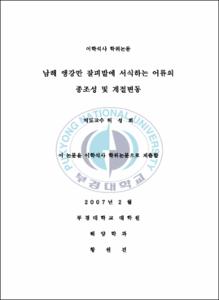남해 앵강만 잘피밭에 서식하는 어류의 종조성 및 계절변동
- Alternative Title
- Species composition and seasonal variations in fishes in the eelgrass (Zostera marina) bed in Aenggang Bay, Korea
- Abstract
- 앵강만 잘피밭에 서식하는 어류의 종조성 및 계절 변동 특성을 파악하기 위해 2005년 1월부터 12월까지 소형 bem trawl과 통발을 이용하여 잘피밭과 잘피가 서식하지 않는 인근 해역으로 나누어 어류를 매월 채집하였다.
본 조사 기간 동안 앵강만 잘피밭에서 소형 beam trawl에 의해 채집된 어류는 총 8목 25과 43종이었다. 조사 기간 동안 그물코쥐치, 가시망둑, 미역치, 복섬, 실고기가 우점하였으며 이들은 총 출현 개체수의 73.0%를 차지하며 우점하였다. 그 다음으로 우점하였던 종은 돌팍망둑, 베도라치, 쥐노래미, 망상어, 흰발망둑, 주둥치였다. 이들은 소형 어종이거나 대형 어종의 유어들로 이루어져 있었다.
본 연구와 동일한 조사 방법으로 실시된 다른 지역의 잘피밭 연구에서 채집된 우점종을 비교해 보면, 지리적으로 가까운 광양만은 본 조사 해역과 우점종이 유사하였으나, 본 조사 해역에서 100 km 정도 떨어져 있는 진동만은 우점종이 큰 차이를 보였다.
앵강만 잘피밭의 어류 군집은 뚜렷한 계절변동을 보였는데 출현종수는 겨울에 10종 미만이 출현하였으나, 봄과 가을에 크게 증가하였으며, 9월에 연중 가장 많은 종수를 나타내었다. 개체수는 겨울에 최소치를 보였으나, 1월부터 계속 증가하여 3월에 가장 높은 수치를 보였으며, 7~8월에 감소한 후, 디시 가을에 많은 개체수를 나타내었다. 생체량은 겨울에 최소치를 보였으나, 3월부터 크게 증가하기 시작하여 봄과 가을에 높았다. 3월에 연중 가장 많은 생체량을 나타내었다. 수온과 잘피의 현존량 및 어류의 주 먹이생물 특히 단각류(카프렐라류, 옆새우류)의 양적 변동이 앵강만 잘피밭 어류 군집의 계절변동에 영향을 미치는 것으로 나타났다.
잘피밭과 잘피가 없는 인접해역에서 채집된 어류를 비교해 보면 출현종수, 개체수, 생체량 모두 잘피가 없는 인근 해역보다 잘피밭에서 높게 나타났다. 또한 잘피밭은 작은 크기의 자·치어들이 많이 출현하였으나, 잘피가 없는 해역에서는 더 큰 크기의 개체들이 많이 출현하였다. 이러한 결과로 미루어 볼 때 잘피밭이 많은 어종들에게 좋은 성육장 역할을 하고 있다고 판단된다.
한편, 잘피밭 어류 연구에 있어서 통발어구의 유용성에 대해 검토해 본 결과. 통발 어구가 특정 해역의 어류 군집 연구에 있어 beam trawl 만큼 효율적으로 어류를 채집 하지 못하지만 잘피가 많이 우거져 있는 시기에 beam trawl과 같은 어구로는 채집이 어려운 어종(붕장어 등)의 채집이 용이하였다. 따라서 잘피밭 어류연구에 있어 beam trawl의 보조 어구로 통발이 사용될 수 있다고 생각된다.
Species composition and seasonal variations of fish assemblages in the eelgrass bed of Aenggnag Bay and in the unvegetated habitats near the eelgrass bed were studied using monthly fish samples collected by a small beam trawl and crab pots from January to December 2005.
During the study period, a total of 43 fish species from 25 families and 8 orders were collected by a small beam trawl in the eelgrass bed. The dominant fish species were Rudarius ercodes, Pseudoblennius cottoides, Hypodytes rubripinnis, Takifugu niphobles and Syngnathus schlegeli and these accounted for 73.0% of the total number of individuals collected. The next dominant fish species were Pseudoblennius percoides, Pholis nebulosa, Hexagrammos otakii, Ditrema temmincki, Acanthogobius lactipes and Leiognathus nuchalis. Most fishes collected in the eelgrass bed belong to primary small fish species or early juveniles of large fish species.
Compared with the fish assemblages in the eelgrass beds of other areas, the fish species composition in the study was similar to that of Kwangyang Bay, which is geographically adjacent, but there were some differences in the fish species composition between Aenggnag Bay and Jindong Bay, which is at a distance of 100 kilometers away from Aenggnag Bay.
The fish assemblage in the eelgrass bed in Aenggnag Bay varied significantly with season. The number of fish species was less than 10 in winter, but increased in spring and autumn, and the highest value occurred in September. The number of individuals was the lowest in winter, but increased from January until March when the highest was recorded, then decreased in summer and increased in autumn again. The biomass was the lowest in winter, but increased in spring and autumn. The highest biomass occurred in March. The seasonal variation of fish assemblage in Aenggang Bay's eelgrass bed occurred due to variations in the water temperature, eelgrass biomass and abundances of major prey organisms, especially amphipod (caprellid amphipod and gammarid amphipod).
Species richness, number of individuals and biomass of fishes in the eelgrass bed were significantly higher than those of unvegetated area. Most fishes collected in the eelgrass bed were primarily small fish species or juveniles of fish species, while larger fishes were collected in the unvegetated area. These results indicated that the eelgrass bed in Aenggang Bay functions as the nursery area for many fish species.
Meanwhile, the investigation of efficiency of crab pots for collecting fishes in eelgrass beds showed that the crab pots were less effective collecting gear than the beam trawl for eelgrass fish community studies, but the crab pots collected fishes effectively which were difficult to collected by the bean trawl during the overgrowing season of the eelgrass. Thus, the crab pots can be used to collect fishes in eelgrass beds as an assistant gear along with the beam trawl for fish community studies in eelgrass beds.
- Issued Date
- 2007
- Awarded Date
- 2007. 2
- Type
- Dissertation
- Publisher
- 부경대학교 대학원
- Alternative Author(s)
- Hwang, Won-Jin
- Affiliation
- 부경대학교 대학원
- Department
- 대학원 해양학과
- Advisor
- 허성희
- Table Of Contents
- Ⅰ. 서론 = 1
Ⅱ. 재료 및 방법 = 3
2.1 시료 채집 = 3
2.2 자료 분석 = 7
Ⅲ. 결과 = 8
3.1 환경특성 = 8
3.2 잘피밭에서 채집된 어류 = 11
3.2.1 빔트롤에 의한 채집 = 11
3.2.2 통발에 의한 채집 = 31
3.3 잘피가 없는 인근 해역에서 채집된 어류 = 34
3.3.1 빔트롤에 의한 채집 = 34
3.3.2 통발에 의한 채집 = 38
Ⅳ. 고찰 = 41
Ⅴ. 요약 = 48
Ⅶ. 참고문헌 = 51
- Degree
- Master
- Files in This Item:
-
-
Download
 남해 앵강만 잘피밭에 서식하는 어류의 종조성 및 계절변동.pdf
기타 데이터 / 818.22 kB / Adobe PDF
남해 앵강만 잘피밭에 서식하는 어류의 종조성 및 계절변동.pdf
기타 데이터 / 818.22 kB / Adobe PDF
-
Items in Repository are protected by copyright, with all rights reserved, unless otherwise indicated.